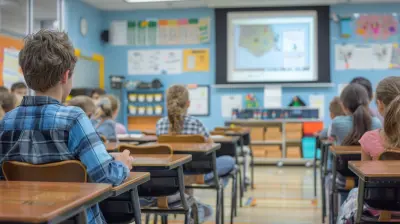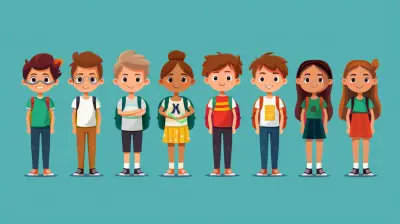Designing a Student-Centered Lesson Plan for Success
10 September 2025
Creating lesson plans used to be all about the teacher — what they were going to teach, how they were going to deliver the content, and what materials they needed. Sound familiar? But let’s be real for a second: that old-school method just doesn’t cut it anymore. Why? Because it leaves out the most important piece of the puzzle — the students.
In this post, we're diving deep into the world of student-centered lesson plans. Not only are they more engaging, but they’re also proven to be more effective. So grab your favorite cup of coffee (or tea, no judgment), and let's break down how to design a student-centered lesson plan that sets your learners up for real success.
What Is a Student-Centered Lesson Plan, Anyway?
Let’s start simple. A student-centered lesson plan flips the script. Instead of the teacher being the star of the show, the spotlight shifts to the student.In this approach, students aren’t just passive recipients of knowledge. They’re active participants. Think of it like a group hike rather than a lecture — the teacher is the guide, but the students are doing the actual exploring.
Teachers still play a crucial role, don’t get me wrong. But the goal is to create a learning environment where students drive their own learning, explore topics in ways that matter to them, and feel invested in their progress.
Why Go Student-Centered?
You might be wondering, “Is this really worth the effort?” Oh, yes. Here’s why:- 🔥 Increased Engagement: When students have a say, they're way more interested.
- 🧠 Better Retention: Active learning boosts long-term memory.
- 💬 Improved Communication Skills: Students learn to express and defend their ideas.
- 🎯 Personalized Learning: Teaching meets kids where they are.
- 💡 Critical Thinking: Encourages problem-solving, not just memorization.
Bottom line? Student-centered plans build thinkers, not just test-takers.
Step-By-Step Guide to Designing a Student-Centered Lesson Plan
Ready to jump in? Let’s walk through the steps to build a lesson plan that actually speaks to students and gets results.1. Start with Clear, Student-Friendly Learning Objectives
Skip the jargon. Students should be able to look at the objective and think, “Okay, I know what I’m supposed to do.”Instead of:
> "Students will analyze the environmental impact of industrialization."
Try:
> "You’ll figure out how factories have changed nature — for better or worse."
Set 2 or 3 clear goals per lesson. Make sure they’re measurable, achievable, and relevant to real life.
2. Know Your Students
Before you even start writing a plan, you’ve got to know who you’re teaching.- What are their interests?
- What challenges do they face?
- How do they like to learn — visually, hands-on, through discussion?
This is where pre-assessments, surveys, or just honest conversations can do wonders. When students feel like the lesson was made for them, they’re way more likely to dig in.
3. Make It Real: Connect Lessons to Life
If students are constantly asking, “Why do I need to know this?” — your lesson needs an upgrade.Tie the content to real-world scenarios:
- If you're teaching fractions, talk about baking.
- Discussing climate change? Look at their own community.
- Reading a novel? Connect it to social media trends or current events.
When students see how a lesson impacts their world, it sticks.
4. Plan for Active Learning
Here's the golden rule: no more than 10-15 minutes of "teacher talk" at a time.Break things up with:
- Group work
- Debates
- Case studies
- Simulations
- Hands-on activities
- Role play
- Research projects
Add in games if you're feeling fancy. Or flip the classroom. Let them teach part of the lesson.
Remember: learning should be an experience, not a lecture.
5. Offer Choices
You know how we all like options in life? Students do too. Offering choices gives them a sense of ownership and control.Instead of assigning one giant paper or task, give them options:
- Create a video
- Design a poster
- Write a script
- Build a model
- Lead a presentation
As long as the objective is met, who cares how they get there? Let them choose their path.
6. Use Formative Assessment with Feedback
Forget waiting until the test to assess learning. Student-centered lessons thrive on ongoing check-ins.Try:
- Exit tickets
- Peer reviews
- Quick polls
- Think-pair-share
- Journals
And here’s the secret sauce: feedback, not grades. Tell students what's working, what isn't, and how they can improve immediately. Make it a conversation, not a score.
7. Reflect and Adjust
After the lesson, don’t just move on. Pause. Reflect.- What worked?
- What flopped?
- Did students meet the objectives?
- What feedback did they give?
Better yet, ask the students. Their insights are like gold for refining your next plan. And hey, it's all part of the process.
Bonus Tips for Making Lesson Plans Fun and Functional
Let’s sprinkle in some extra goodies to take your student-centered lesson game from good to great:🔄 Incorporate Technology
Whether it’s Google Slides, Canva, Kahoot, or Padlet — tech tools can help students collaborate, create, and explore in fresh ways.🌍 Be Culturally Responsive
Include diverse voices, backgrounds, and perspectives in your materials. This makes every student feel seen and heard.🧰 Keep a Toolkit Ready
Maintain a stash of quick activities, prompts, and games that you can plug into any lesson. They’re lifesavers when things go off-script.⏳ Be Flexible
Student-centered learning can be unpredictable — and that’s a good thing. Be okay with adjusting timelines or changing directions if the class energy or curiosity calls for it.Real-Life Example: Student-Centered Science Lesson Plan
Here's a quick sneak peek at how all this might look in action.Objective:
Students will understand the effects of pollution on local ecosystems.
Hook:
Show a short video of a polluted beach. Ask: “If this happened in our town, what would we do?”
Activity Choices:
- Research and present on a local ecosystem
- Create a PSA video about pollution
- Write a letter to the mayor suggesting cleanup initiatives
Assessment:
- Peer feedback on presentations
- Reflective journal on what they learned and how it applies to their lives
Simple? Yes. Powerful? Absolutely.
The Mindset Shift: You’re a Coach, Not a Commander
Being student-centered means giving up a little control. That can feel scary at first. But think about the long-term payoff:- Students own their learning.
- They feel capable and heard.
- They grow into independent thinkers.
And isn’t that the whole point of education?
So next time you're drafting a lesson plan, ask yourself:
👉 “Is this built with the student or just for them?”
Wrapping Up: Give Students the Driver’s Seat
Designing a student-centered classroom doesn’t mean tossing your structure out the window. It means shifting the focus from “What do I need to teach?” to “What will help my students learn best?”When you craft lesson plans that put student needs, interests, and voices first, you're not just teaching — you're transforming the learning experience.
So take the leap. Try something new. And trust your students to lead the way.
They might just surprise you.
all images in this post were generated using AI tools
Category:
Lesson PlansAuthor:

Eva Barker
Discussion
rate this article
1 comments
Zethryn Cain
Great insights on student-centered lesson planning! Incorporating diverse learning styles and active engagement strategies can significantly enhance student success. Looking forward to implementing these ideas in my classroom!
September 22, 2025 at 2:47 AM

Eva Barker
Thank you for your feedback! I'm thrilled to hear that you found the insights helpful. Best of luck implementing these strategies in your classroom!


